Want to know how to start a personal development blog like this one?
You’re in luck!
This is the ultimate guide to starting a blog in the personal development niche.
Here’s what you’ll learn:
- How to find your self-help niche
- Choosing your blog name
- Ways to monetize your blog
- Build and design your blog (in less than 1 hour)
- How to find self-help blog topics
- And much more
By the end of this post, you’ll know exactly how to start a self help blog you can use to market yourself, your brand, or business.
Let’s dive in.
Table of Contents
Quick 5 Step Process to Starting a Personal Growth Blog
Just want the steps? Here they are:
- Choose your niche (mental health, wealth, fitness, mindset, habit…)
- Register your domain name here (e.g. grandhabit.com)
- Get web hosting here (get $10 off your first year here)
- Install WordPress (only takes a few minutes)
- Choose a theme (I’m using GeneratePress)
- Write your first article
Keep reading the steps below to know exactly what to do.
Highest Rated Blogging Course – Over 1,600 Happy Students! Enroll Today.
Why Start a Self Help Blog?
If you read my business ideas for introverts post, you might have decided to start a blogging business.
But why choose personal development as your blogging niche?
Here’s the deal:
Everyone wants to improve themselves and the self-help industry is massive.
Another benefit with a personal growth blog is that there are tons of sub-niches to choose from, so you won’t be up against the likes of Tony Robbins or Brian Tracy.
More on choosing your niche later.
For now, here are a few more reasons you might want to start a self-help blog.
- to promote your coaching services
- to share your own personal success
- help people achieve their goals
- to learn business and digital marketing
- to diversify your income with display ads or affiliate marketing
- or to practice a valuable skill, like writing
Now, let’s break down the exact steps for starting a self help blog.
How to Start a Personal Development Blog That Makes Money in 2023
Follow this 9 step process for starting a personal development blog.
1. Choose your niche
If you want to reach success with a personal development blog, you’ll need to niche down a bit.
Why?
Because if you’re starting from scratch, no body knows who you are. You can’t just rock up as the next Tony Robbins expecting to be taken seriously.
You’ve got build some trust and authority first. And it’s much easier to do this in a smaller niche.
Here are just a few you can start out in:
- mindfulness
- happiness
- habits
- productivity
- advanced life skills
- self-actualization
If you’ve read a few books on productivity or live your life from a strict schedule, this would be a great niche for you to get into.
However, it’s important not to get too caught up in your decision. You can start with anything and branch into other things later.
Once you have an idea for a niche, you’ll have a better idea of what to name your blog.
In the next step, I’ll share some ideas to help you define your blog name and where to register your domain name.
2. Register your domain name (e.g. grandhabit.com)
If you know what you want to call your blog, you can register your domain name with Namecheap.
This is where I register all my blog ideas, because they don’t overcharge and don’t use pushy marketing strategies.
If you need help to choose a blog name, follow these simple guidelines:
- Opt for a .com or .co extension if you can, it looks more professional and easier to remember
- Aim to keep your domain name short. Try limiting it to two words
- Choose a name that resembles your niche
- Try finding a name that sounds brandable. This adds more value to your blog
- Make it easy to say and remember
- Avoid trademarked names (check here (US) or here (UK) to see what’s trademarked)
- Check to see if your chosen name is available on social media (use namecheckr.com)
Here’s an example:
Let’s say your niche is mindfulness. Try to find a word that resembles mindfulness. You can use Thesaurus.com to get synonyms.
Here are some I found:
- care
- thought
- peace
- calm
- stoic
- serene
Then pair these words with a descriptive word or noun, similar to these:
- base
- lab
- mill
- growth
- gain
- rise
- success
- boost
When you combine these words together, here’s what they look like:
- serenelab
- stoicmill
- stoicrise
- stoiclab
- calmrise
- calmboost
- peacemill
- thoughtboost
- carebase
- carelab
Now use namecheckr.com to see which of your names is available. These are the ones I found:
- stoicmill.com
- stoicrise.com
These were the only ones from my list that were available. This one also had all social media usernames available, which is a bonus!

If I didn’t like these names, I would need to look for some more words to pair together.
But when you find one you like, head over to Namecheap to register it.

Add to your cart and purchase the domain.
In the next step, I’ll show you how to get web hosting, connect it with your domain name, and launch WordPress.
3. Get web hosting (get $10 off your first year)
While you’re still on the Namecheap website, head over to their web hosting service for WordPress here.
This package is perfect for new bloggers and it’s really easy to launch your blog:
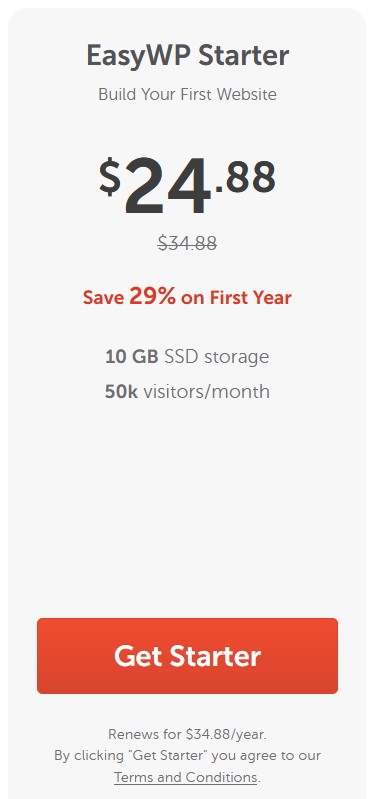
Click the button and confirm the payment on the next page.
Continue on the next step where I show you how to launch WordPress.
4. Install WordPress (WordPress is the best!)
On the next page, you’ll be asked to enter your website name:
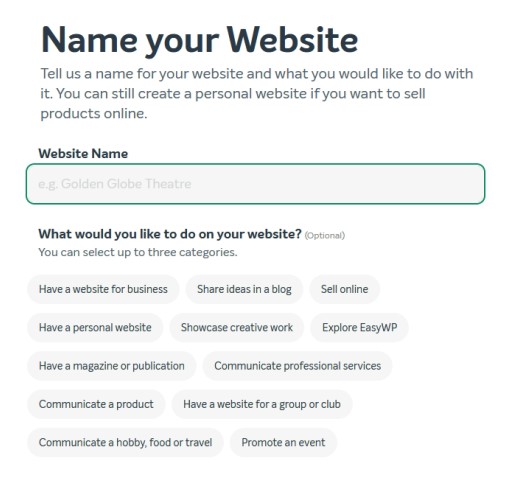
On the next page, choose Your domain you registered on Namecheap and select it from the dropdown.
Continue through the other steps, choosing any theme and skipping the plugins.
Review your details at the end and Namecheap will start installing WordPress on the last step.
Once it’s complete, you’ll be able to access your WordPress site.
Access your WordPress admin by clicking WP Admin or navigating to yourdomain.com/wp-admin/.

Now you’re in the admin of your blog. In the next step, I’ll show you how to install a WordPress theme. It’s super easy!
5. Choose a theme (I’m using GeneratePress)
Many people get stuck on which theme to choose for their blog, but try not to overthink it in the beginning.
Here are a few great starter themes that are super easy to set up and need little tweaking:
Challenger – A simple WordPress theme with a powerful pro version. Great for beginners looking for something easy to use.
Blogfeedly – Super basic blog style theme if you just want to focus on publishing content.
Here are some more advanced themes that offer more features and allow you to fully customize the design, great for upgrading to these when you have more time to tweak your design.
Astra – One of the most popular themes for WordPress.
GeneratePress – what I use for Grand Habit and the pro version has a ton of customizations.
Whichever theme you decide on, follow these steps to get started:
I’ll show you how to install GeneratePress, but the process is the same for any theme. The only difference is the customizations you have access to with other themes.
Head over to Appearance > Themes > Add new in your WP admin and search generatepress:
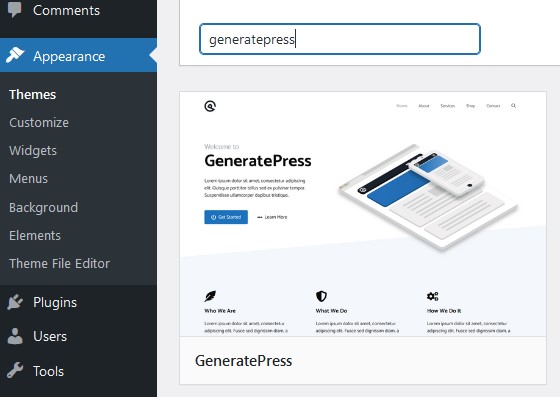
Activate the theme and go check your home page:
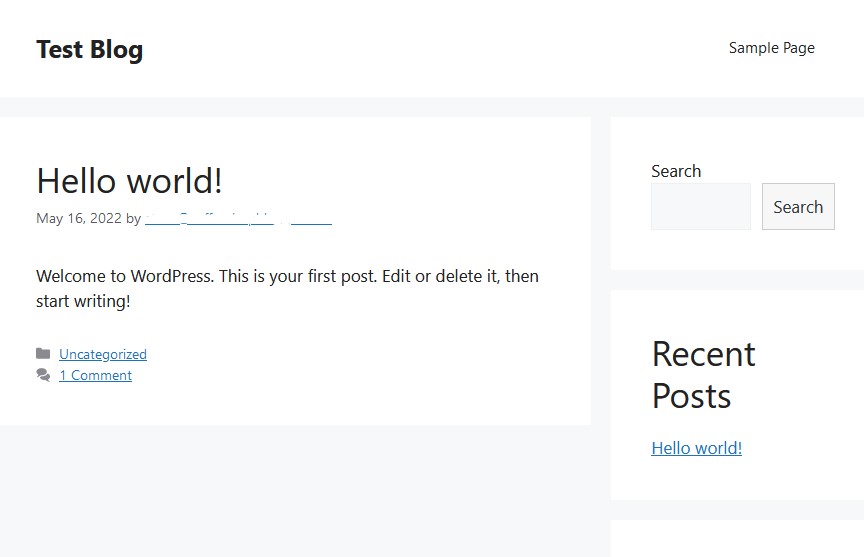
You can check some options in the theme customizer, but the free version of GeneratePress is minimal.
When you add articles to your blog (more on this later), you’ll get a better idea of what your blog will look like using this theme.
Here is a new manifestation blog I started recently, which is currently using the Blogfeedly theme. I’ll be switching to GeneratePress soon.
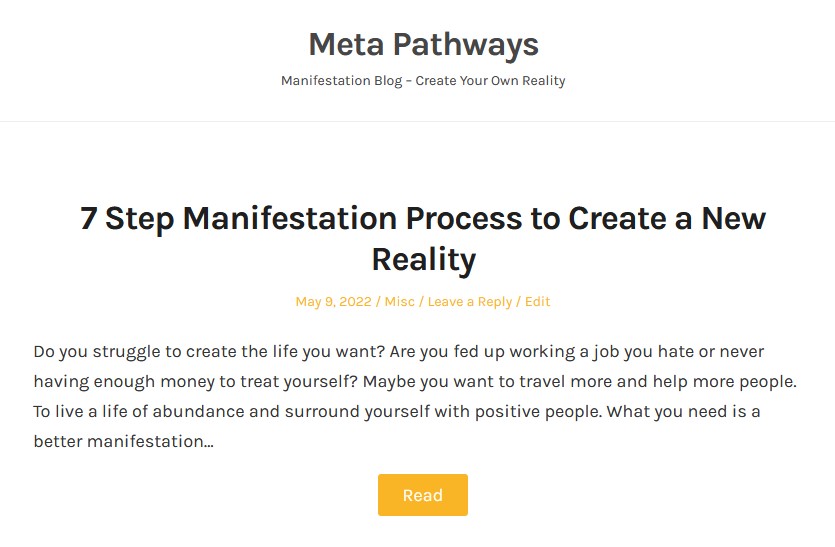
In the early stages of blogging, I prefer to focus my time on publishing articles. The design can be improved later.
6. Must have plugins for a self-help blog
Here’s a list of WordPress plugins that are useful for any blog.
Antispam Bee – Prevents spammers and bots from posting comments on your blog.
RankMath or Yoast SEO – An SEO plugin which allows you to customize how your articles show up in search results.
NinjaFirewall or All In One WP Security & Firewall – A security plugin to protect your blog from hackers. Either of these can be activated and used straight out of the box to give better security, but they also have more advanced options if you want to increase security on your blog.
WP AutoTerms – Automatically creates terms and conditions pages and privacy policy for your blog.
Beautiful Cookie Consent Banner – If you need to comply to EU GDPR rules, you’ll need a plugin like this one.
The following aren’t as important in the beginning, but will definitely help when your blog gets more popular.
WPRocket or Autoptimize – Speeds up your blog for better user experience.
Social warfare – Social media share buttons so readers can share your articles on their social media channels.
7. How to find blog topics to write about
Finding blog topics can be easy or difficult depending on how you look at it.
There are thousands of other blogs that offer a ton of inspiration when finding things to write about.
Or knowing this can overwhelm you with self-doubt and imposter syndrome.
The truth is, there is something you know well enough that could help thousands of people live better lives.
Your job is to find this area of knowledge you are interested in sharing your perspective on.
You don’t need to be an expert, only a unique voice with interesting views on the subject.
To uncover these topics, use Google to find other blogs in your chosen self-help niche.
If I use mindfulness as an example, I would look at blogs such as these:
- ZenHabits
- TinyBuddha
- HappierHuman
Make a list of blogs related to your niche and go through some of their articles. Find ones you think you could include on your own blog.
The idea is to share your own perspective, not copy or rehash what already exists.
To speed up this process, use a tool like KWFinder to find out what people are searching for online.
This is an important step to determine which keywords to use for your articles, otherwise you could create content that no one is searching for.
You can also use this tool to search the domain to see which keywords they are ranking for.
This is a great way to reverse engineer competing blogs that are already doing well in your niche.
Just remember that you are better off targeting lower volume keywords in the beginning.
If the blog you’re getting keywords from is ranking #1 for “how to practice mindfulness” and the keyword volume is in the thousands, your new blog will have difficulty ranking for it.
That’s because a new blog doesn’t have any content or authority in the eyes of Google yet.
You need to aim for much lower search volume keywords in the beginning (between 10 – 200 is ideal), and build up relevancy on your blog.
The more relevant each of your articles are, the easier Google will know what your blog is about and start ranking your articles.
Therefore, it’s so important to stick to a tight niche and focus entirely on that area for at least 30 articles.
Then you can start venturing out to other areas that relate to the first one.
In the mindfulness niche, that could look like these topics:
- Meditation
- Self-awareness
- Journaling
- Breathwork
Break down the categories of your niche and focus on one at a time. Build your blog traffic and audience by adding as much valuable content as possible.
The key is to develop a consistent writing practice so that it becomes a habit.
Succeeding with your blog takes time, but consistency and determination will pay off in 6 months, 1 year, and 2 years from now.
8. Write your first article
By now, you should have a list of article ideas and their keywords.
The key to writing articles for your personal development blog is to balance creative writing with the keywords you find.
What this means is you don’t want keywords to limit your potential, but you also don’t want to write 100 articles without doing some keyword research first.
With that said, here’s a framework to follow when writing your first batch of articles.
- Use the keyword in the title and slug (the URL after the domain name)
- Outline your article with 7-9 subheadings
- Make your intros brief or use a short story that people can relate with
- Try to write more than 1000 words. This is best for SEO and providing enough value
- Link your articles together to provide more content and value for the reader
9. Set your personal development blogging goal
If you want to become a successful blogger and grow a personal development business, then you’ve got to develop consistency.
Success doesn’t come from trying a bunch of things and hoping it works.
You have to do one thing repeatedly until you learn what works and what doesn’t work.
To do that with a self-help blog, you’ll want to set yourself a goal, either based on traffic or a specific number of articles published.
A good starting point would be to publish 30 articles or get 1000 visitors per month. Visitors will be a difficult metric to track in the beginning, because it takes a while for SEO traffic to grow.
Unless you’re driving traffic from social media, try sticking to one goal at a time.
Posting 30 articles is a good amount to see some traction for how your content is performing, which will help you know where to focus on moving forward.
How to Monetize a Personal Development Blog
There are tons of ways you can monetize your blog, and you can start with some of them right away if you like.
Here is the most common way to make money with a blog.
Affiliate Marketing
Affiliate marketing is where you link to a product from your articles and the company pays you a commission when someone buys through your link.
The most popular affiliate programs include Amazon, ClickBank, Rakuten Advertising, and Share a Sale.
You can also promote course through Udemy, Mindvalley, Skillshare, and Masterclass.
Display Ads
Display ads have come a long way in recent years. For instance, Ezoic now allows newbie bloggers to join their ad platform, instead of needing 10,000 visitors per months.
Ads work by showing up between the text on your blog and in the sidebar, and you get paid by the number of visitors you get multiplied by your RPM. RPMs differ depending on your niche.
If you have an RPM of $25 and you get 100,000 pageviews, then your ad revenue will be $2,500.
Digital Products
This is where you create your own ebooks or courses and sell them directly to your audience.
If you set up your blog well and develop a good strategy, digital products can make you a lot of money, because the profit margins are so high.
This could be something you do once your blog gets more popular and you have an audience you can ask for feedback on.
You can also look at your most popular content to determine what your digital product can help with and provide the most amount of value.
How to Grow Your Personal Development Blog
The most important thing to focus on though is your audience and the specific area you would like to help them with.
Think of your blog as an entire book on achieving a specific outcome. And each blog post is a mini chapter.
People who want to change their lives are usually thinking of achieving a goal.
That could be:
- Finding purpose of meaning in life
- Feeling happier and having less stress
- Developing more structure and certainty
- Improving their relationships
- Making more money
- Getting healthier or in better shape
- Becoming an entrepreneur or starting a business
The easiest thing you could start with is with a goal you have already achieved.
Create content that helps your readers achieve what comes easy to you and that you know a lot about.
If it’s something you can talk about for hours, then you’re onto something and your blog will succeed.
How to Start a Personal Development Blog Conclusion
Blogging is a fantastic way of building a following and growing your business, and you don’t even nneed your own products.
If you want to help people change their lives, then start a personal development blog.
You will also learn a lot about yourself along the way, so it’s a perfect business to start if you’re working on yourself.
Image by Peter Olexa from Pixabay

Hi Steve!! It’s 2:41am and I stumbled upon your site based on searching for Florence Scovel Schinn affirmations lol and wow!!! You know how the Divine Bridge of Events work… I feel I was meant to find your website. I have always wanted to start a Personal Development Blog. Mainly to just have somewhere to express all the experiences I go through on my journey. Whether or not it gets monetized is not my priority but it would be great to connect with some like-minded people since I really feel like I’m alone sometimes without anyone to talk about these things with bc those around me are just not awakened yet. Even thought I’ve tried. Thank you so much!!!
Hi Ashley, thanks so much for your comment. I’ve been thinking about starting a mini community where people like us can help guide eachother in this journey. I’m just unsure which platform, as I find things like FB groups distracting. Feel free to reach out on Instagram (@steveallenhere) though, I’d be happy to chat about this topic on there 🙂
Thanks for making Steve
Keep up the good work :)